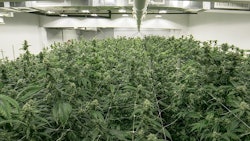
It’s no secret that cannabis cultivation is resource-intensive, from water use to energy consumption. For growers looking to save on utility bills and improve their environmental footprint, options are available, such as cutting ties with the municipal water system, implementing water reclamation and taking advantage of utility rebates.
Mantis Growth Investments founder Jesse Peters was the co-founder and CEO of Eco Firma Farms, a 23,000-square-foot indoor, carbon-neutral grow operation in Oregon that became a subsidiary of C21 Investments in 2018. Here, he discusses how cannabis cultivators can operate a more sustainable and profitable operation.
Cannabis Business Times: What are some ways that cannabis cultivators can cut water usage in their operation?
Jesse Peters: There are two trains of thought here regarding indoor cultivation, where this is typically more common for questions regarding water conservation. There is the municipal system and the farm system for water and waste.
My first suggestion: If possible, get out of the city. Get out of the municipal system if you can. This is an unnecessary expense. If one is in a farm system with a well and septic, they do not need to pay for water and sewer. This is also better on the environment, as doing a drain-to-waste system will put nutrients down the drain and into our rivers and streams. If one is on farm land, they can build a bioswale with native plants that will use the nutrients from the runoff water to grow, consume CO2 and produce O2, all while cleaning the water before it goes back into the ground.
If one is forced to be in an urban environment, there are some solutions. First, equipment exists that can filter nutrients back out of water, so the water is usable again. Some other options are to capture the runoff nutrient water and re-use it multiple times by supplementing what has been lost in the first or second pass. This takes some research and testing, but is a great option as one is now saving on water, sewer and nutrient cost. Another option is to recapture the water coming from the dehumidifiers. This water can be stored and placed back on the plants, or even filtered and plumbed through the facility for human use. As water cannot be destroyed, only polluted, the question is; “How do I not pollute the water so I can reuse what I have already paid for rather than dispose of it?”
CBT: How can cultivators use utility rebates to their advantage?
JP: Call and apply! These organizations are there to give away money, literally. If they do not give out all their grant money for the year, they will receive less the following year, so they are eager to help one find ways to qualify.
A big pitfall to watch out for are leasing companies that prey on one’s lack of knowledge in these programs. They will offer zero-percent financing on equipment that qualifies for large grants—primarily LED lights. The offer is that in the application process, one must agree to sign over the right to the grant to the leasing company in exchange for the zero-percent financing. The leasing company will do all the paperwork for the lessor. What most lessors do not realize is that they are essentially giving away 50 percent of their purchase price back to the leasing company in a check from the utility company weeks after the equipment is installed. My biggest advice on this point is don’t be afraid to contact your utility company and ask about energy saving rebates directly.
CBT: What are some ways to improve waste management practices in a cultivation facility?
JP: This is difficult. At Eco Firma, when we owned it, we attempted to eliminate all waste. The goal was to completely end our garbage service and only have recycling. This was a massive undertaking. The best advice I can give is to start smaller and work your way up. Start by implementing a large recycling program. Make it very easy for the employees to recycle. Place bins everywhere, with very clear directions. Create incentive programs for employees who create new ways to eliminate waste—make it fun. At one point, we had employees competing on who could go longer without needing to throw anything away or bringing in any waste. They were actually washing out their sandwich bags and bringing them home to reuse. From there, get rid of straws, then move to getting rid of plastic. One step at a time—you don’t need to be perfect overnight, just always moving forward to the end goal.
CBT: What is one of your favorite tips for cultivators to be more sustainable?
JP: Start small and don’t be afraid to ask questions and challenge the norm. We all got here by challenging the norms—don’t stop now. This is our chance to change far more in the world than just cannabis on a state level. Think globally, and just be a good human; the rest will come if you stick to that.
Editor's Note: This interview has been edited for style, length and clarity.























